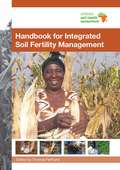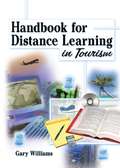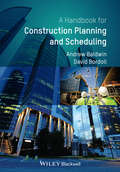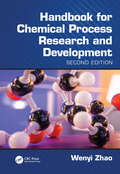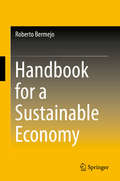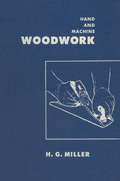- Table View
- List View
The Handbook for Market Research for Life Sciences Companies: Finding the Answers You Need to Understand Your Market
by Jean-Francois DenaultAs innovation moves from the lab to the market, a new research phase begins for the entrepreneur: the market research phase. Inspired by a new technology that can change the world, critical questions need to be addressed. Is there a market for my innovation? Who are my clients? What do they need? Is my innovation filling that gap in the market? Who are my competitors? How are they approaching the market? If these questions are unaswered, entrepreneurs meet potential investors or partners with only a basic understanding of their market. The objective of this book is to fill this gap. It is a practical manual that gives entrepreneurs real-world advice and tools to build a solid market model. The book provides tips, models and tools entrepreneurs can use to collect, interpret and present their market and integrate it into their business plan. What the entrepreneur learns in this book will help him throughout his journey. After going over the market research process, he will learn how to design and use a number of market research tools, and how to adapt them in a life science context. From building a web survey to preparing interviews to doing your own secondary research, this handbook will help him gain a comprehensive understanding of how to perform his own market research activities and how to analyze his data. Finally, a number of frameworks (such as the TAM-SAM-SOM as well as the KANO Model) are described so that he can efficiently share what he has learned, using models that simply yet effectively shares findings.
The Handbook for Market Research for Life Sciences Companies: Finding the Answers You Need to Understand Your Market
by Jean-Francois DenaultAs innovation moves from the lab to the market, a new research phase begins for the entrepreneur: the market research phase. Inspired by a new technology that can change the world, critical questions need to be addressed. Is there a market for my innovation? Who are my clients? What do they need? Is my innovation filling that gap in the market? Who are my competitors? How are they approaching the market? If these questions are unaswered, entrepreneurs meet potential investors or partners with only a basic understanding of their market. The objective of this book is to fill this gap. It is a practical manual that gives entrepreneurs real-world advice and tools to build a solid market model. The book provides tips, models and tools entrepreneurs can use to collect, interpret and present their market and integrate it into their business plan. What the entrepreneur learns in this book will help him throughout his journey. After going over the market research process, he will learn how to design and use a number of market research tools, and how to adapt them in a life science context. From building a web survey to preparing interviews to doing your own secondary research, this handbook will help him gain a comprehensive understanding of how to perform his own market research activities and how to analyze his data. Finally, a number of frameworks (such as the TAM-SAM-SOM as well as the KANO Model) are described so that he can efficiently share what he has learned, using models that simply yet effectively shares findings.
Handbook for Integrated Soil Fertility Management
This handbook presents Integrated Soil Fertility Management, commonly known as ISFM, as a key contributor to improving Africa's soil and crop productivity, especially for the key staples in the continent that include maize, legumes, rice, cassava, bananas, sorghum, millet and coffee. It is meant for training of extension workers on soil fertility management techniques in sub-Saharan Africa and for workers involved in rural development that would like to learn more about the principles of ISFM. The handbook is also a useful primer on ISFM for educational organizations such as universities and technical colleges, and organizations involved in the development of policy on agriculture and rural development that need reference materials on ISFM techniques. Produced by the Africa Soil Health Consortium (ASHC), this handbook is part of a series of materials and publications on ISFM produced for stakeholders including extension personnel, smallholder farmers, agro-dealers, policy makers and training institutions. Other materials include cropping and plant nutrition guides, policy briefs, training manuals and practical information for extension workers and farmers. See the ASHC website for further details. The ASHC works with initiatives in sub-Saharan Africa to encourage the uptake of ISFM practices. ASHC is coordinated by CABI in partnership with international and national science and agriculture organizations with support from the Bill & Melinda Gates Foundation.
Handbook for III-V High Electron Mobility Transistor Technologies
by D. Nirmal J. AjayanThis book focusses on III-V high electron mobility transistors (HEMTs) including basic physics, material used, fabrications details, modeling, simulation, and other important aspects. It initiates by describing principle of operation, material systems and material technologies followed by description of the structure, I-V characteristics, modeling of DC and RF parameters of AlGaN/GaN HEMTs. The book also provides information about source/drain engineering, gate engineering and channel engineering techniques used to improve the DC-RF and breakdown performance of HEMTs. Finally, the book also highlights the importance of metal oxide semiconductor high electron mobility transistors (MOS-HEMT). Key Features Combines III-As/P/N HEMTs with reliability and current status in single volume Includes AC/DC modelling and (sub)millimeter wave devices with reliability analysis Covers all theoretical and experimental aspects of HEMTs Discusses AlGaN/GaN transistors Presents DC, RF and breakdown characteristics of HEMTs on various material systems using graphs and plots
Handbook for III-V High Electron Mobility Transistor Technologies
by D. Nirmal J. AjayanThis book focusses on III-V high electron mobility transistors (HEMTs) including basic physics, material used, fabrications details, modeling, simulation, and other important aspects. It initiates by describing principle of operation, material systems and material technologies followed by description of the structure, I-V characteristics, modeling of DC and RF parameters of AlGaN/GaN HEMTs. The book also provides information about source/drain engineering, gate engineering and channel engineering techniques used to improve the DC-RF and breakdown performance of HEMTs. Finally, the book also highlights the importance of metal oxide semiconductor high electron mobility transistors (MOS-HEMT). Key Features Combines III-As/P/N HEMTs with reliability and current status in single volume Includes AC/DC modelling and (sub)millimeter wave devices with reliability analysis Covers all theoretical and experimental aspects of HEMTs Discusses AlGaN/GaN transistors Presents DC, RF and breakdown characteristics of HEMTs on various material systems using graphs and plots
Handbook for Heat Exchangers and Tube Banks design
by Donatello AnnaratoneThe motion of fluids is never in parallel- or counter-flow in heat exchangers and tube banks, leading to complexities in the equations for calculating their transferred heat and temperatures. This review of the topic includes 70 design and verification tables.
Handbook for Environmental Risk Decision Making: Values, Perceptions, and Ethics
by C. Richard CothernThis handbook describes the broad aspects of risk management involving scientific policy judgment, uncertainty analysis, perception considerations, statistical insights, and strategic thinking. This book presents all the important concepts to enable the reader to "see the big picture." This ability is extremely important - it allows the decision ma
Handbook for Environmental Risk Decision Making: Values, Perceptions, and Ethics
by C. Richard CothernThis handbook describes the broad aspects of risk management involving scientific policy judgment, uncertainty analysis, perception considerations, statistical insights, and strategic thinking. This book presents all the important concepts to enable the reader to "see the big picture." This ability is extremely important - it allows the decision ma
Handbook for Distance Learning in Tourism
by Kaye Sung ChonDeliver quality instruction to your students-on-campus or offThe Handbook for Distance Learning in Tourism is a practical, down-to-earth guide to developing and using print-based and Internet-based flexible learning resources for courses where students rarely, if ever, attend on-campus classes. Whether you&’re a teacher who needs to develop course notes into a flexible learning package, a Web site, or both, or you just want information about how to teach in a flexible environment, the book will provide the help you need-in language you can understand. Designed to guide you through the completion of a project-or a semester-this hands-on book offers strategies, suggestions, hints, and examples, and includes a hotel and tourism case study that illustrates effective concepts and strategies.Written by Gary Williams, co-editor of The Internet and Travel and Tourism Education (Haworth), this unique book will help you develop print-based and Internet-based learning resources instead of focusing only on one or the other, breaking down the barriers placed between learning environments. The strategies presented are timeless, with no comparisons of specific commercial or noncommercial products to become outdated and no Web site addresses to become useless. The book makes extensive use of tables, graphics, and illustrations and has its own Web site that&’s regularly updated, listing online resources arranged on a chapter-by-chapter basis.The Handbook for Distance Learning in Tourism examines: the roles and characteristics of a project manager developing and buying resources considerations before committing to a project maximizing project ownership ensuring quality content educational design guidelines media foundations production, design, and maintenance of print resources developing and using Web sites computer-mediated contact course management systems (CMS) and much more!The Handbook for Distance Learning in Tourism is an invaluable guidebook for educators working in the field of hotel and tourism management as well as academics, project managers, and educational designers who are interested in flexible learning developments.
Handbook for Distance Learning in Tourism
by Kaye Sung ChonDeliver quality instruction to your students-on-campus or offThe Handbook for Distance Learning in Tourism is a practical, down-to-earth guide to developing and using print-based and Internet-based flexible learning resources for courses where students rarely, if ever, attend on-campus classes. Whether you&’re a teacher who needs to develop course notes into a flexible learning package, a Web site, or both, or you just want information about how to teach in a flexible environment, the book will provide the help you need-in language you can understand. Designed to guide you through the completion of a project-or a semester-this hands-on book offers strategies, suggestions, hints, and examples, and includes a hotel and tourism case study that illustrates effective concepts and strategies.Written by Gary Williams, co-editor of The Internet and Travel and Tourism Education (Haworth), this unique book will help you develop print-based and Internet-based learning resources instead of focusing only on one or the other, breaking down the barriers placed between learning environments. The strategies presented are timeless, with no comparisons of specific commercial or noncommercial products to become outdated and no Web site addresses to become useless. The book makes extensive use of tables, graphics, and illustrations and has its own Web site that&’s regularly updated, listing online resources arranged on a chapter-by-chapter basis.The Handbook for Distance Learning in Tourism examines: the roles and characteristics of a project manager developing and buying resources considerations before committing to a project maximizing project ownership ensuring quality content educational design guidelines media foundations production, design, and maintenance of print resources developing and using Web sites computer-mediated contact course management systems (CMS) and much more!The Handbook for Distance Learning in Tourism is an invaluable guidebook for educators working in the field of hotel and tourism management as well as academics, project managers, and educational designers who are interested in flexible learning developments.
Handbook for Critical Cleaning, Second Edition - 2 Volume Set
by Barbara Kanegsberg Edward KanegsbergThis set consists of two volumes: Cleaning Agents and Systems and Applications, Processes, and Controls. Updated, expanded, re-organized, and rewritten, this two-volume handbook covers cleaning processes, applications, management, safety, and environmental concerns. The editors rigorously examine technical issues, cleaning agent options and systems, chemical and equipment integration, and contamination control, as well as cleanliness standards, analytical testing, process selection, implementation and maintenance, specific application areas, and regulatory issues. A collection of international contributors gives the text a global viewpoint. Color illustrations, video clips, and animation are available online to help readers better understand presented material.
Handbook for Construction Planning and Scheduling
by Andrew Baldwin David BordoliThe authoritative industry guide on good practice for planning and scheduling in construction This handbook acts as a guide to good practice, a text to accompany learning and a reference document for those needing information on background, best practice, and methods for practical application. A Handbook for Construction Planning & Scheduling presents the key issues of planning and programming in scheduling in a clear, concise and practical way. The book divides into four main sections: Planning and Scheduling within the Construction Context; Planning and Scheduling Techniques and Practices; Planning and Scheduling Methods; Delay and Forensic Analysis. The authors include both basic concepts and updates on current topics demanding close attention from the construction industry, including planning for sustainability, waste, health and safety and Building Information Modelling (BIM). The book is especially useful for early career practitioners - engineers, quantity surveyors, construction managers, project managers - who may already have a basic grounding in civil engineering, building and general construction but lack extensive planning and scheduling experience. Students will find the website helpful with worked examples of the methods and calculations for typical construction projects plus other directed learning material. This authoritative industry guide on good practice for planning and scheduling in construction is written in a direct, informative style with a clear presentation enabling easy access of the relevant information with a companion website providing additional resources and learning support material. the authoritative industry guide on construction planning and scheduling direct informative writing style and clear presentation enables easy access of the relevant information companion website provides additional learning material.
Handbook for Construction Planning and Scheduling
by Andrew Baldwin David BordoliThe authoritative industry guide on good practice for planning and scheduling in construction This handbook acts as a guide to good practice, a text to accompany learning and a reference document for those needing information on background, best practice, and methods for practical application. A Handbook for Construction Planning & Scheduling presents the key issues of planning and programming in scheduling in a clear, concise and practical way. The book divides into four main sections: Planning and Scheduling within the Construction Context; Planning and Scheduling Techniques and Practices; Planning and Scheduling Methods; Delay and Forensic Analysis. The authors include both basic concepts and updates on current topics demanding close attention from the construction industry, including planning for sustainability, waste, health and safety and Building Information Modelling (BIM). The book is especially useful for early career practitioners - engineers, quantity surveyors, construction managers, project managers - who may already have a basic grounding in civil engineering, building and general construction but lack extensive planning and scheduling experience. Students will find the website helpful with worked examples of the methods and calculations for typical construction projects plus other directed learning material. This authoritative industry guide on good practice for planning and scheduling in construction is written in a direct, informative style with a clear presentation enabling easy access of the relevant information with a companion website providing additional resources and learning support material. the authoritative industry guide on construction planning and scheduling direct informative writing style and clear presentation enables easy access of the relevant information companion website provides additional learning material.
Handbook for Cleaning for Semiconductor Manufacturing: Fundamentals and Applications (Wiley-Scrivener #67)
by Karen A. Reinhardt Richard F. ReidyThis comprehensive volume provides an in-depth discussion of the fundamentals of cleaning and surface conditioning of semiconductor applications such as high-k/metal gate cleaning, copper/low-k cleaning, high dose implant stripping, and silicon and SiGe passivation. The theory and fundamental physics associated with wet etching and wet cleaning is reviewed, plus the surface and colloidal aspects of wet processing. Formulation development practices and methodology are presented along with the applications for preventing copper corrosion, cleaning aluminum lines, and other sensitive layers. This is a must-have reference for any engineer or manager associated with using or supplying cleaning and contamination free technologies for semiconductor manufacturing. From the Reviews... "This handbook will be a valuable resource for many academic libraries. Many engineering librarians who work with a variety of programs (including, but not limited to Materials Engineering) should include this work in their collection. My recommendation is to add this work to any collection that serves a campus with a materials/manufacturing/electrical/computer engineering programs and campuses with departments of physics and/or chemistry with large graduate-level enrollment." —Randy Wallace, Department Head, Discovery Park Library, University of North Texas
Handbook for Cleaning for Semiconductor Manufacturing: Fundamentals and Applications (Wiley-Scrivener #53)
by Karen A. Reinhardt Richard F. ReidyThis comprehensive volume provides an in-depth discussion of the fundamentals of cleaning and surface conditioning of semiconductor applications such as high-k/metal gate cleaning, copper/low-k cleaning, high dose implant stripping, and silicon and SiGe passivation. The theory and fundamental physics associated with wet etching and wet cleaning is reviewed, plus the surface and colloidal aspects of wet processing. Formulation development practices and methodology are presented along with the applications for preventing copper corrosion, cleaning aluminum lines, and other sensitive layers. This is a must-have reference for any engineer or manager associated with using or supplying cleaning and contamination free technologies for semiconductor manufacturing. From the Reviews... "This handbook will be a valuable resource for many academic libraries. Many engineering librarians who work with a variety of programs (including, but not limited to Materials Engineering) should include this work in their collection. My recommendation is to add this work to any collection that serves a campus with a materials/manufacturing/electrical/computer engineering programs and campuses with departments of physics and/or chemistry with large graduate-level enrollment." —Randy Wallace, Department Head, Discovery Park Library, University of North Texas
Handbook for Chemical Process Research and Development, Second Edition
by Wenyi ZhaoThis fully updated second edition reflects the significant changes in process chemistry since the first edition and includes more common process issues such as safety, cost, robustness, and environmental impact. Some areas have made notable progress such as process safety, stereochemistry, new reagents and reagent surrogates. Forty years ago there were few process research and development activities in the pharmaceutical industry, partly due to the simplicity of drug molecules. With increasing structural complexity especially the introduction of chiral centers into drug molecules and stricter regulations, process R&D has become one of the critical departments for pharmaceutical companies. Features: This unique volume now in its second edition is designed to provide readers with an unprecedented strategy and approach which will help chemists and graduate students develop chemical processes in an efficient manner. Promotes an industrial mindset concerning safety and commercial viability when developing methods. The author discusses development strategies with case studies and experimental procedures. Focuses on mechanism-guided process development which provides readers with practical strategies and approaches. Addresses more common process issues such as safety, cost, robustness, and environmental impact. This book provides a new direction for scientists, researchers, and students in materials science and polymer chemistry who seek to better understand the chemistry behind conducting polymers and improve their performance for use in advanced energy applications.
Handbook for Chemical Process Research and Development, Second Edition
by Wenyi ZhaoThis fully updated second edition reflects the significant changes in process chemistry since the first edition and includes more common process issues such as safety, cost, robustness, and environmental impact. Some areas have made notable progress such as process safety, stereochemistry, new reagents and reagent surrogates. Forty years ago there were few process research and development activities in the pharmaceutical industry, partly due to the simplicity of drug molecules. With increasing structural complexity especially the introduction of chiral centers into drug molecules and stricter regulations, process R&D has become one of the critical departments for pharmaceutical companies. Features: This unique volume now in its second edition is designed to provide readers with an unprecedented strategy and approach which will help chemists and graduate students develop chemical processes in an efficient manner. Promotes an industrial mindset concerning safety and commercial viability when developing methods. The author discusses development strategies with case studies and experimental procedures. Focuses on mechanism-guided process development which provides readers with practical strategies and approaches. Addresses more common process issues such as safety, cost, robustness, and environmental impact. This book provides a new direction for scientists, researchers, and students in materials science and polymer chemistry who seek to better understand the chemistry behind conducting polymers and improve their performance for use in advanced energy applications.
Handbook for Chemical Process Industries
by Himanshu J PatelChemical processing industry plays a pivotal role in the economy of a country, as chemicals are required in every sphere of our lives. This book covers chemical processing of dyes, pigments, drugs and pharmaceutical products, fermented products, agrochemicals, explosives, polymers, Period II and III chemicals, chemicals, sugar, coatings, starches, soaps and detergents, paper, pulp, glass, and cement. It includes sources of natural materials, collection process, purification, and extraction of different chemicals from natural materials like petroleum, coal and ores from the Earth. It includes manufacturing details of C1 to C4 and aromatic compounds obtained from natural materials. The book covers both traditional and modern sectors of the chemical processing industry. It provides knowledge on the properties of the chemical and manufacturing process (such as raw materials, chemical reactions, quantitative requirement, flow sheet diagram, procedure) and its uses. The book is based on the author's expertise and has been developed with an awareness of the quantitative requirement for manufacturing chemicals. Data has been collected from industry, thus it will be useful to industry personnel, research groups, academicians and institutional organizations.
Handbook for Chemical Process Industries
by Himanshu J PatelChemical processing industry plays a pivotal role in the economy of a country, as chemicals are required in every sphere of our lives. This book covers chemical processing of dyes, pigments, drugs and pharmaceutical products, fermented products, agrochemicals, explosives, polymers, Period II and III chemicals, chemicals, sugar, coatings, starches, soaps and detergents, paper, pulp, glass, and cement. It includes sources of natural materials, collection process, purification, and extraction of different chemicals from natural materials like petroleum, coal and ores from the Earth. It includes manufacturing details of C1 to C4 and aromatic compounds obtained from natural materials. The book covers both traditional and modern sectors of the chemical processing industry. It provides knowledge on the properties of the chemical and manufacturing process (such as raw materials, chemical reactions, quantitative requirement, flow sheet diagram, procedure) and its uses. The book is based on the author's expertise and has been developed with an awareness of the quantitative requirement for manufacturing chemicals. Data has been collected from industry, thus it will be useful to industry personnel, research groups, academicians and institutional organizations.
A Handbook for Analytical Writing: Keys to Strategic Thinking (Synthesis Lectures on Professionalism and Career Advancement for Scientists and Engineers)
by William E. WinnerThis handbook accelerates the development of analytical writing skills for high school students, students in higher education, and working professionals in a broad range of careers. This handbook builds on the idea that writing clarifies thought, and that through analytical writing comes improved insight and understanding for making decisions about innovation necessary for socioeconomic development. This short handbook is a simple, comprehensive guide that shows differences between descriptive writing and analytical writing, and how students and teachers work together during the process of discovery-based learning. This handbook provides nuts and bolts ideas for team projects, organizing writing, the process of writing, constructing tables, presenting figures, documenting reference lists, avoiding the barriers to clear writing, and outlines the importance of ethical issues and bias for writers. Finally, there are ideas for evaluating writing, and examples of classroom exercises for students and teachers.
Handbook for a Sustainable Economy
by Roberto BermejoSince the 1992 World Scientists’ Warning to Humanity, the looming prospect of Earth’s changing climate has inspired a broad movement dedicated to a sustainable future. In this Handbook, the author explains the elements of a sustainable economy, the development of which must be undertaken if we are to retain our civilization.The first section offers a critical analysis of orthodox economical thinking, and the tools used by the conventional economy to solve the “environmental problem.” The author examines the theory and tools of Environmental Economics addressing the commodification of nature, and offers analysis of the theoretical and practical contradictions which arise from attempts to combine environmental protection and free trade.Part II discusses the principles and tools needed to build a sustainable economy, including the concept of biomimicry as a guiding principle of sustainability, a brief description of the adaptive cycle of ecosystems and explains the concept of transformability and the factors that determine it. Discussion includes a broad evaluation of the capacity for transformation of National Sustainable Development Strategies and an analysis of the essential requirements of ecology-based tax reform. Also included is a critical vision of the dominant paradigm of science and technology.The third section explores sustainable production and consumption, discussing energy, transport, the circular economy of materials and sustainable consumption. Included are a detailed analysis of factors that determine the limits of fossil fuels, a description of the peak oil structural effect and its sectoral impacts, an overview of a sustainable electric system and a review of biofuels, electricity and hydrogen. The author concludes that only hydrogen associated to fuel offers a sustainable alternative to oil. Discussion includes a view of the structural causes of the current high-level consumption model through the lens of motivation, provision and access systems and a detailed description of policies that must be adopted as part of a sustainable consumption strategy.The final chapter undertakes the task of analyzing the capability of our societies to transform themselves to reach sustainability. The author broadly evaluates each factor, as a prior step to carrying out an overall evaluation and demonstrates that in order to accomplish a comprehensive analysis, a multidisciplinary group is necessary.
Handbook Factory Planning and Design
by Hans-Peter Wiendahl Jürgen Reichardt Peter NyhuisThis handbook introduces a methodical approach and pragmatic concept for the planning and design of changeable factories that act in strategic alliances to supply the ever-changing needs of the global market.In the first part, the change drivers of manufacturing enterprises and the resulting new challenges are considered in detail with focus on an appropriate change potential.The second part concerns the design of the production facilities and systems on the factory levels work place, section, building and site under functional, organisational, architectural and strategic aspects keeping in mind the environmental, health and safety aspects including corporate social responsibility.The third part is dedicated to the planning and design method that is based on a synergetic interaction of process and space. The accompanying project management of the planning and construction phase and the facility management for the effective utilization of the built premises close the book.The AuthorsProf. em. Dr.-Ing. Dr. mult. h.c. Hans-Peter Wiendahl has been director for 23 years of the Institute of Factory planning and Logistics at the Leibniz University of Hannover in Germany.Prof. Dipl.-Ing. Architekt BDA Jürgen Reichardt is Professor at the Muenster school of architecture and partner of RMA Reichardt – Maas – Associate Architects in Essen Germany.Prof. Dr.-Ing. habil. Peter Nyhuis is Managing Director of the Institute of Factory Planning and Logistics at the Leibniz University of Hannover in Germany.
Handbook Digital Farming: Digital Transformation for Sustainable Agriculture
by Jörg Dörr Matthias NachtmannThe Handbook Digital Farming sheds light on the technological, economic, social, and legal perspectives of the digital transformation. The authors of the individual chapters explain the state of the art and the development of business models, enabling readers to draw conclusions for their own organizations. They also provide an outlook on trends, and further developments. The handbook provides technological facts from renowned experts and concrete business examples from experienced companies and start-ups. It is aimed at farmers, farm and business managers, decision-makers and developers of digital tools and strategies in the agri-food sector, as well as scientists and students. The handbook provides insights to the discussion of what contribution digital farming can make to the implementation of Green Deal, Farm to Fork and the new Common Agricultural Policy.

